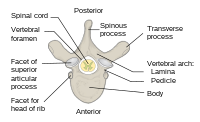
Back Werwel Afrikaans فقرة (تشريح) Arabic ܦܩܪܐ ARC Fəqərə Azerbaijani Умыртҡа Bashkir Пазванок Byelorussian Прешлен Bulgarian কশেরুকা Bengali/Bangla Kičmeni pršljen BS Vèrtebra Catalan
| Vertebra | |
|---|---|
 A typical vertebra, superior view | |
 A section of the human vertebral column, showing multiple vertebrae in a left posterolateral view. | |
| Details | |
| Part of | Spinal column |
| Identifiers | |
| Latin | vertebra |
| TA98 | A02.2.01.001 |
| TA2 | 1011 |
| FMA | 9914 |
| Anatomical terms of bone | |
Each vertebra (pl.: vertebrae) is an irregular bone with a complex structure composed of bone and some hyaline cartilage, that make up the vertebral column or spine, of vertebrates. The proportions of the vertebrae differ according to their spinal segment and the particular species.
The basic configuration of a vertebra varies; the bone is the body, and the central part of the body is the centrum. The upper and lower surfaces of the vertebra body give attachment to the intervertebral discs. The posterior part of a vertebra forms a vertebral arch, in eleven parts, consisting of two pedicles (pedicle of vertebral arch), two laminae, and seven processes. The laminae give attachment to the ligamenta flava (ligaments of the spine). There are vertebral notches formed from the shape of the pedicles, which form the intervertebral foramina when the vertebrae articulate. These foramina are the entry and exit conduits for the spinal nerves. The body of the vertebra and the vertebral arch form the vertebral foramen, the larger, central opening that accommodates the spinal canal, which encloses and protects the spinal cord.
Vertebrae articulate with each other to give strength and flexibility to the spinal column, and the shape at their back and front aspects determines the range of movement. Structurally, vertebrae are essentially alike across the vertebrate species, with the greatest difference seen between an aquatic animal and other vertebrate animals. As such, vertebrates take their name from the vertebrae that compose the vertebral column.
© MMXXIII Rich X Search. We shall prevail. All rights reserved. Rich X Search